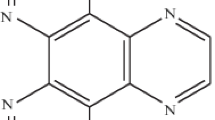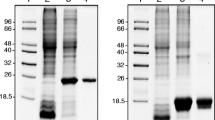Abstract
Copper/zinc (Cu/ZnSOD) and manganese (MnSOD) superoxide dismutases which catalyze the dismutation of toxic superoxide anion, O sup−inf2 , to O2 and H2O2, play a major role in protecting cells from toxicity of oxidative stress. However, cells overexpressing either form of the enzyme show signs of toxicity, suggesting that too much SOD may he injurious to the cell. To elucidate the possible mechanism of this cytotoxicity, the effect of SOD on DNA and RNA strand scission was studied. High purity preparations of Cu/ZnSOD and MnSOD were tested in an in vitro assay in which DNA cleavage was measured by conversion of phage φX174 supercoiled double-stranded DNA to open circular and linear forms. Both types of SOD were able to induce DNA strand scission generating single- and double-strand breaks in a process that required oxygen and the presence of fully active enzyme. The DNA strand scission could be prevented by specific anti-SOD antibodies added directly or used for immunodepletion of SOD. Requirement for oxygen and the effect of Fe(II) and Fe(III) ions suggest that cleavage of DNA may be in part mediated by hydroxyl radicals formed in Fenton-type reactions where enzyme-bound transition metals serve as a catalyst by first being reduced by superoxide and then oxidized by H2O2. Another mechanism was probably operative in this system, since in the presence of magnesium DNA cleavage by SOD was oxygen independent and not affected by sodium cyanide. It is postulated that SOD, by having a similar structure to the active center of zinc-containing nucleases, is capable of exhibiting non-specific nuclease activity causing hydrolysis of the phosphodiester bonds of DNA and RNA. Both types of SOD were shown to effectively cleave RNA. These findings may help explain the origin of pathology of certain hereditary diseases genetically linked to Cu/ZnSOD gene.
Similar content being viewed by others
References
Avraham KB, Schickler M, Sapoznikov D, Yavanu R, Groner Y. 1988 Down's syndrome: Abnormal neuromuscular junction in tongue of transgenic mice with elevated levels of human Cu/Zn-superoxide dismutase. Cell 54, 823–829.
Bannister JV, Bannister WH, Rotilio G. 1987 Aspects of the structure, function and application of superoxide dismutase. CRC Crit Rev Biochem 22, 111–180.
Basile CA, Baston JK. 1989 Metallonucleases: Real and artificial. In: Sigel H, Sigel A, eds. Metal Ions in Biological Systems. New York: Marcel Dekker; 31–103.
Borchelt DR, Lee MK, Slunt HS, et al. 1994 Superoxide dismutase 1 subunits with mutations linked to familial amyotrophic lateral sclerosis do not affect wild-type subunit function. Proc Natl Acad Sci USA 91, 8292–8296.
Brown RJ Jr. 1995 Amyotrophic lateral sclerosis: recent insight from genetics and transgenic mice. Cell 80, 687–692.
Davies MJ. 1988 Detection of peroxyl and alkoxyl radicals produced by reaction of hydroperoxides with hemeproteins by electron spin resonance spectroscopy. Biochem Biophys Acta 964, 28–35.
Elroy-Stein O, Groner Y. 1988 Impaired neurotransmitter uptake in PC/12 cells overexpressing human CuZnSOD -implication for gene dosage effects in Down syndrom. Cell 52, 259–267.
Elroy-Stein O, Berstein Y, Groner Y. 1986 Over-production of human Cu/Zn-superoxide dismutase in transfected cells: extenuation of paraquat-mediated cytotoxicity and enhancement of lipid peroxidation. EMBO J 5, 615–622.
Epstein CJ, Avraham KB, Lovett M, et al. 1987 Transgenic mice with increased CuZn-superoxide dismutase activity: animal model of dosage effects in Down's syndrome. Proc Natl Acad Sci USA 84, 8044–8048.
Fridovich I. 1978 The biology of oxygen radicals. Science 201, 875–880.
Gregory EM, Goscin SA, Fridovich I. 1974 Superoxide dismutase and oxygen toxicity in eukaryotes. J Bacteriol 117, 456–460.
Gurney ME, Pu H, Chiu AY, et al. 1994 Motor neuron degeneration in mice that express a human Cu,Zn superoxide dismutase. Science 264, 1772–1775.
Halliwell B, Gulteridge JMC. 1990 Role of free radicals and catalytic metal ions in human disease: an overview. Methods Enzymol 186, 1–85.
Harris JI, Steinman HM. 1977 Amino acid sequence homologies among superoxide dismutases. In: Michelson AM, McCord JM, Fridovich J, eds. Superoxide and Superoxide Dismutases. New York: Academic Press: 225–230.
Hartz, JW, Funakoshi S, Deutsch HF. 1973 The levels of superoxide dismutase and catalase in human tissues as determined immunochemically. Clin Chim Acta 46, 125–132.
Imlay JA, Linn S. 1988 DNA damage and oxygen radical toxicity. Science 240, 1302–1309.
Kasprzak KS. 1991 The role of oxidative damage in metal carcinogenicity. Chem Res Toxicol 4, 604–615.
Mavelli I, Cirido MR, Rossi L, el al. 1984 Favism, a hemolytic disease associated with increased superoxide dismutase and decreased glutathione peroxidase activities in blood cells. Eur J Biochem 139, 13–18.
McCord JM, Fridovich I. 1969 Superoxide dismutase. An enzymatic function for erythrocuprein (hemocuprein). J Biol Chem 244, 6049–6055.
McCord JM, Keel BB Jr, Fridovich I. 1971 An enzyme-based theory of obligate anaerobiosis. The physiological function of superoxide dismutase. Proc Natl Acad Sci USA 68, 1024–1027.
Norris KH, Horrisby PJ. 1990 Cytotoxic effects of expression of human SOD in bovine adrenocortical cells. Mutat Res 237, 95–106.
Otvos JD, Browne DT. 1980 Characterization of the properties of the multiple metal binding sites in alkaline phosphatase by carbon-13 nuclear magnetic resonance. Biochemistry 19, 4011–4021.
Ripps ME, Huntley GW, Hof PR, Morrison JH, Gordon JW. 1995 Transgenic mice expressing an altered murine superoxide dismutase gene provide an animal model of amyotrophic lateral sclerosis. Proc Natl Acad Sci USA 92, 689–692.
Rosen DR, Siddique T, Patterson D, et al. 1993 Mutations in Cu/Zn superoxide dismutase gene are associated with familial amyotrophic lateral sclerosis. Nature 362, 59–62.
Sato K, Akaike T, Kohno M, et al. 1992 Hydroxyl radical production by hydrogen peroxide plus Cu,Zn-super-oxide dismutase reflects the activity of free copper-released from the oxidative damaged enzyme. J Biol Chem 267, 25371–25377.
Scott MD, Meshnick SR, Eaton JW. 1987 Superoxide dismutase-rich bacteria. J Biol Chem 262, 3640–3645.
Sinet PM. 1977 In: Michelson AM, McCord JM, Fridovich J, eds. Superoxide and Superoxide Dismutases. New York: Academic Press: 225–230.
Stallings WC, Pattridge, KA, Strong RK, et al. 1985 The structure of manganese superoxide dismutase from Thermus thermophilus HB8 at 2.4-åA resolution. J Biol Chem 260, 16424–16432.
Summit RL 1981 In: de la Cruz FF, Gerald SS, eds. Trisomy 21 (Down's syndrome): Research Perspectives. Baltimore: University Park Press: 225–235.
Thomas JP, Bachowski GJ, Girotti A. 1986 Inhibition of cell membrane lipid peroxidation by cadmium and zinc-metallothioneins. Biochem Biophys Acta 884, 448–453.
Tainer JA, Getzoff ED, Beem KM, et al. 1982 Determination and analysis of the 2 Å structure of copper, zinc superoxide dismutase. J Mol Biol 160, 181–217.
Winterbourne CC, Hawkins RE, Brian M, et al. 1975 The estimation of red cell superoxide dismutase activity. J Lab Clin Med 85, 337–341.
Yim MB, Chock PB, Stadtman ER. 1990 Copper, zinc superoxide dismutase catalyzes hydroxyl radical production from hydrogen peroxide. Proc Natl Acad Sci USA 87, 5006–5010.
Author information
Authors and Affiliations
Rights and permissions
About this article
Cite this article
Dowjat, W.K., Kharatishvili, M. & Costa, M. DNA and RNA strand scission by copper, zinc and manganese superoxide dismutases. Biometals 9, 327–335 (1996). https://doi.org/10.1007/BF00140601
Received:
Accepted:
Issue Date:
DOI: https://doi.org/10.1007/BF00140601




